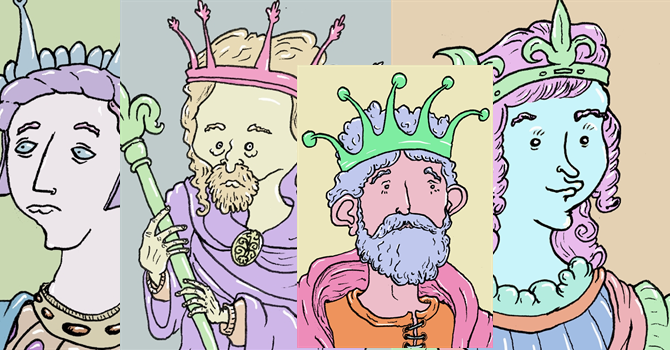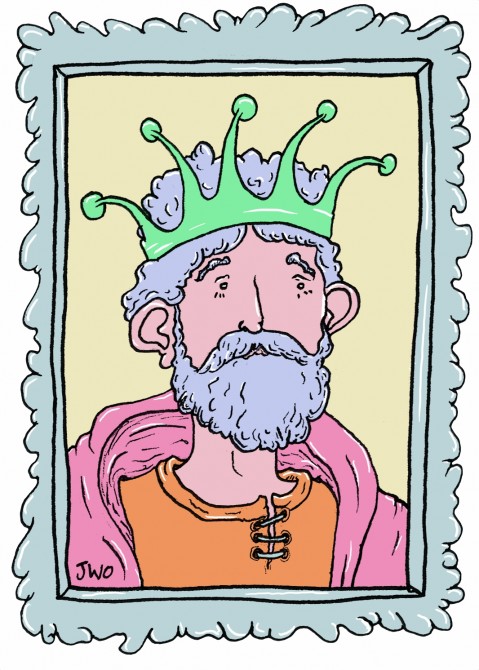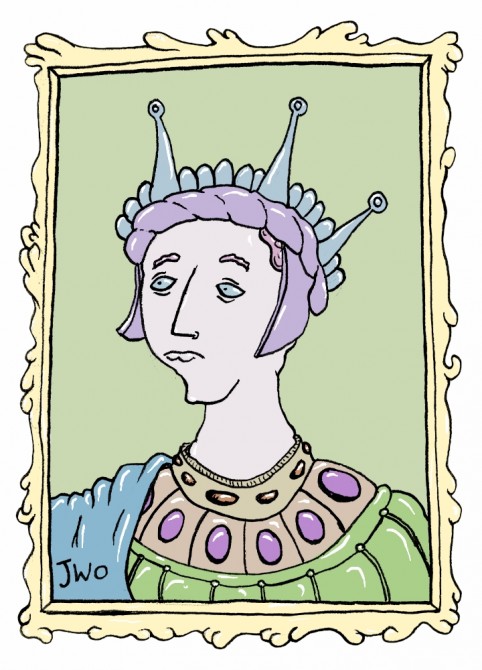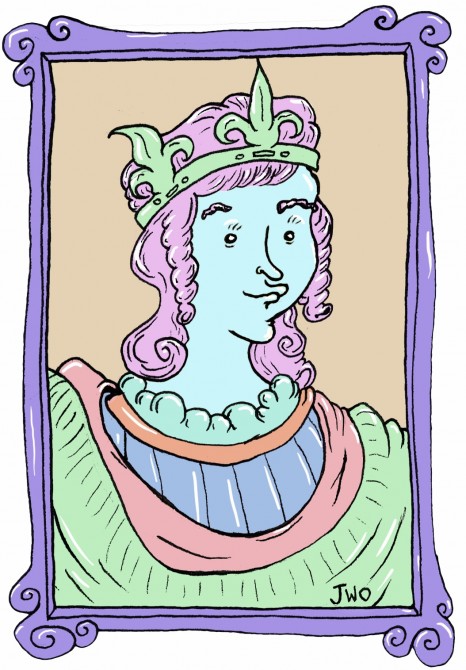
For those of you that have followed my series on the monarchs, I’ve taken a slightly different turn this time. Initially I was working backwards from present day to ancient history, tracing the odd and potted history of our fearless leaders. As I drifted back in time I found myself getting rather confused, describing a son, then the father, then the grandfather. My feeble little brain got lost in the mire. So I’ve changed tack. I’m going to do a post here about the very first Kings of England. Hopefully I will find it easier to hold the thread between my quivering brain marbles.
Once again, the talented Jack West-Oram at Ichi Nichi Drawings has come along for the ride and provided these magniloquent pieces of art you see before you. Thanks Jack. You are a dude.
If you fancy a recap on my past historical endeavors, here’s your links:
☛ Read First: Monarchs Of Britain — Snapshots of History For Dunces #1
☛ Read Second: Monarchs Of Britain — Snapshots Of History For Dunces #2
☛ Read Third: Monarchs Of England — Snapshots Of History For Dunces #3
Here we go…..
Æthelstan
927-939

Æthelstan was Grandson of Alfred the Great, so he was always destined to be impressive. Initially he was just King of the West Saxons, but in 927 he smashed the last viking stronghold of York and became the first chap to be King of the whole of merry old England. In the same year he managed to draw a submission from the Welsh and Scottish Kings which meant he was pretty well respected and powerful. Not a whole load is known about Æthelstan seeing as it was so long ago and most people didn’t use Facebook and/or Twitter back then. The Anglo-Saxon Chronicle is generally a good source of info for that age but for some reason it doesn’t mention him much. A guy called William of Malmesbury, thankfully, did give us some deets about him though.
Æthelstan was educated by his uncle and aunt, Æthelflæd and Æthelred, don’t ask me how you pronounce his aunt’s name but it looks like it would sound ace. After his father Edward died, his eldest son Ælfweard was due to hit the throne, but he died a few days later which put Æthelstan in line to be King of Wessex. Not everyone was too keen on him being king apparently and there was a plot to blind him which, thankfully for him, never came to fruition.
When he had his coronation he was the first king to wear a crown rather than a helmet; copying the French fashion it seems. Aside from his fancy hat fashions, he never married or had kids and was apparently most comfortable in the company of men. No need to read between the lines there then. He was called “pillar of the dignity of the western world” in the words of the Annals of Ulster and was very well respected throughout Europe which was pretty rare for a Brit back in those days. Errant princes were often sent to him from foreign climbs to be royally whipped into shape. He was also charged with the care of other princes who’s families had been killed at war or were lost in other ways; some of the people he looked after include Norwegian Hákon (king 934—61); Alan, heir to the duchy of Brittany (936—52); and the future Louis IV, king of the West Franks (936—54).
Æthelstan also invented a board game called Die Of The Evangelist and set up a law that decreed the death penalty for anyone over 12 years old stealing goods worth more than eight pence. He wasn’t a fan of theft and thought it heralded the breakdown of society. He later realised he’d been a bit harsh and reigned it in, so you’d only get executed if you were over the ripe old age of 15.
He died in 939, aged 44, and was buried in Malmesbury (this is irrelevant, but just so you know, the area code for Malmesbury is 01666 – heavy metal) and his 18 year old half-brother Edmund took over the gauntlet……
Edmund I
939 – 946

After Æthelstan’s death, Edmund, his half-brother took over. He was also known as the Elder, the Deed-doer, the Just, and the Magnificent. He did a good job of winning parts of northern England and the midlands back off of those crazy Vikings, but not much else seems to have been remembered about his reign, only the manner of his death: Edmund was attending St Augustine’s Day mass in Pucklechurch when he spotted a bloke called Leofa who had been exiled for stealing. Edmund went over to him to give him a bollocking but Leofa killed him with a knife. The crowd then turned on Leofa and he was also killed. So quite a dramatic ending at least.
Eadred
946 – 955

Eadred took over the throne when his elder brother was murdered. Again there doesn’t seem to be much information about the man himself, but he also ran a number of campaigns against Viking nutters who tried to keep Northumbria for themselves, one of these being the heavily metalled name of Eric ‘Bloodaxe’. It was during Eadred’s reign that Northumbria finally gave in to English power. On his way home from a battle in the North, Eric’s troops attacked him and he got a bit of a kicking, this really wound him up and he threatened to ravage all of Northumbria unless the locals stopped hanging around with Bloodaxe. The Northumbrians decided to stick with the English king, after all, Eric had been thrown out of his own blood thirsty country for being too blood thristy so they probably thought they’d be better off without him.
Eadred, towards the end of his life, had problems with his tum tum and a chronicler of the time described with vivid memory how he sucked out the juices of his food, chewed on what was left then spat it out. His digestive malady was to be the death of him at the young age of 32.
Eadwig
955-959

Eadwig was Eadred’s nephew and was chosen by nobles to have a go at being king next seeing as Eadred hadn’t produced an heir. Eadwig, just 16 at the time of his ascension seems like he might have been a bit of trouble, one story tells of how he wound up and scrapped with one of the important old noble bishops of the time: Dunstan. The feud with Dunstan began on the day of Eadwig’s coronation, when he failed to attend a meeting of nobles. Dunstan eventually found the young monarch cavorting with a noblewoman, Æthelgifu, and her daughter in bed together. What a player. He, understandably refused to return with the bishop. Dunstan kicked off and dragged Eadwig back and forced him to renounce the girl as a “strumpet”. Later realizing that he had provoked the king, Dunstan fled to the apparent sanctuary of his cloister, but Eadwig, incited by Æthelgifu, followed him and plundered the monastery. Dunstan managed to escape but he refused to return to England until after Eadwig’s death. The full details of the story have probably been embellished over time, but it makes for a good yarn.
He eventually went on to marry Ælfgifu, the daughter he had been canoodling with but the marriage was anulled because the courts deemed they were “too related”. It was probably a political move though as our current queen and her hubby are actually slightly more related than Eadwig and his wifey! He died at a young age, probably late teens, but no one is sure why.
So there concludes this brief tale of the beginnings of the English monarchy.
☛ Read Next: Monarchs Of Britain — Snapshots of History For Dunces #1















